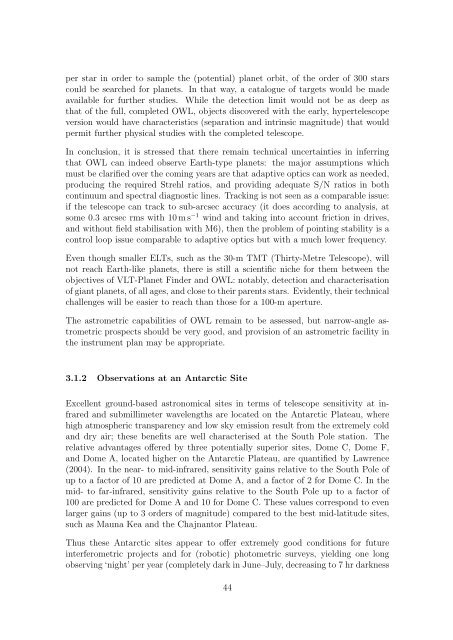Report - School of Physics
Report - School of Physics
Report - School of Physics
You also want an ePaper? Increase the reach of your titles
YUMPU automatically turns print PDFs into web optimized ePapers that Google loves.
per star in order to sample the (potential) planet orbit, <strong>of</strong> the order <strong>of</strong> 300 stars<br />
could be searched for planets. In that way, a catalogue <strong>of</strong> targets would be made<br />
available for further studies. While the detection limit would not be as deep as<br />
that <strong>of</strong> the full, completed OWL, objects discovered with the early, hypertelescope<br />
version would have characteristics (separation and intrinsic magnitude) that would<br />
permit further physical studies with the completed telescope.<br />
In conclusion, it is stressed that there remain technical uncertainties in inferring<br />
that OWL can indeed observe Earth-type planets: the major assumptions which<br />
must be clarified over the coming years are that adaptive optics can work as needed,<br />
producing the required Strehl ratios, and providing adequate S/N ratios in both<br />
continuum and spectral diagnostic lines. Tracking is not seen as a comparable issue:<br />
if the telescope can track to sub-arcsec accuracy (it does according to analysis, at<br />
some 0.3 arcsec rms with 10 m s −1 wind and taking into account friction in drives,<br />
and without field stabilisation with M6), then the problem <strong>of</strong> pointing stability is a<br />
control loop issue comparable to adaptive optics but with a much lower frequency.<br />
Even though smaller ELTs, such as the 30-m TMT (Thirty-Metre Telescope), will<br />
not reach Earth-like planets, there is still a scientific niche for them between the<br />
objectives <strong>of</strong> VLT-Planet Finder and OWL: notably, detection and characterisation<br />
<strong>of</strong> giant planets, <strong>of</strong> all ages, and close to their parents stars. Evidently, their technical<br />
challenges will be easier to reach than those for a 100-m aperture.<br />
The astrometric capabilities <strong>of</strong> OWL remain to be assessed, but narrow-angle astrometric<br />
prospects should be very good, and provision <strong>of</strong> an astrometric facility in<br />
the instrument plan may be appropriate.<br />
3.1.2 Observations at an Antarctic Site<br />
Excellent ground-based astronomical sites in terms <strong>of</strong> telescope sensitivity at infrared<br />
and submillimeter wavelengths are located on the Antarctic Plateau, where<br />
high atmospheric transparency and low sky emission result from the extremely cold<br />
and dry air; these benefits are well characterised at the South Pole station. The<br />
relative advantages <strong>of</strong>fered by three potentially superior sites, Dome C, Dome F,<br />
and Dome A, located higher on the Antarctic Plateau, are quantified by Lawrence<br />
(2004). In the near- to mid-infrared, sensitivity gains relative to the South Pole <strong>of</strong><br />
up to a factor <strong>of</strong> 10 are predicted at Dome A, and a factor <strong>of</strong> 2 for Dome C. In the<br />
mid- to far-infrared, sensitivity gains relative to the South Pole up to a factor <strong>of</strong><br />
100 are predicted for Dome A and 10 for Dome C. These values correspond to even<br />
larger gains (up to 3 orders <strong>of</strong> magnitude) compared to the best mid-latitude sites,<br />
such as Mauna Kea and the Chajnantor Plateau.<br />
Thus these Antarctic sites appear to <strong>of</strong>fer extremely good conditions for future<br />
interferometric projects and for (robotic) photometric surveys, yielding one long<br />
observing ‘night’ per year (completely dark in June–July, decreasing to 7 hr darkness<br />
44
















